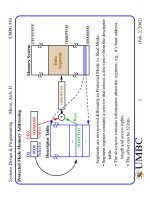Thiết kế và lập trình hệ thống - Chương3
Bạn đang xem bản rút gọn của tài liệu. Xem và tải ngay bản đầy đủ của tài liệu tại đây (196.07 KB, 14 trang )
Systems Design & Programming Micro. Arch. II CMPE 310
1 (Feb. 2, 2002)
UMBC
U M B C
U
N
I
V
E
R
S
I
T
Y
O
F
M
A
R
Y
L
A
N
D
B
A
L
T
I
M
O
R
E
C
O
U
N
T
Y
1
9
6
6
Protected Mode Memory Addressing
Segments are interpreted differently in Protected Mode vs. Real Mode:
• Segment register contains a selector that selects a descriptor from the descriptor
table.
• The descriptor contains information about the segment, e.g., it’s base address,
length and access rights.
• The offset can be 32-bits.
Descriptor Table
FFFFFFFF
00000000
DS
0008
Memory System
Data
Segment
...
...
+
EBX
... 0000FF00
0000FF00
0000FF88
Selector
00000088
Offset
Base
Systems Design & Programming Micro. Arch. II CMPE 310
2 (Feb. 2, 2002)
UMBC
U M B C
U
N
I
V
E
R
S
I
T
Y
O
F
M
A
R
Y
L
A
N
D
B
A
L
T
I
M
O
R
E
C
O
U
N
T
Y
1
9
6
6
Segment Descriptors in Protected Mode
• Base address:
Starting location of the memory segment.
• Limit:
Length of the segment minus 1.
20-bits allows segments up to 1 MB.
This value is shifted by 12 bits to the left when the G (Granularity bit) is set to 1.
Limit
0
1539
1640
Base
(L15-L0)
(B23-B0)
Access
Rights
47
48
(L19-
55
56
Base
(B31-B24)
L16)
01234567
G D X U
51
52
63
byte
P DPL S ATYPE
Systems Design & Programming Micro. Arch. II CMPE 310
3 (Feb. 2, 2002)
UMBC
U M B C
U
N
I
V
E
R
S
I
T
Y
O
F
M
A
R
Y
L
A
N
D
B
A
L
T
I
M
O
R
E
C
O
U
N
T
Y
1
9
6
6
Segment Descriptors in Protected Mode
Segment Descriptors: Bits 52-55
• G bit:
When G=0, segments can be 1 byte to 1MB in length.
When G=1, segments can be 4KB to 4GB in length.
• U bit:
User (OS) defined bit.
• D bit:
Indicates how the instructions (80386 and up) access register and memory data
in protected mode.
• When D=0, instructions are 16-bit instructions, with 16-bit offsets and 16-bit
registers. Stacks are assumed 16-bit wide and SP is used.
• When D=1, 32-bits are assumed.
Allows 8086-80286 programs to run.
• X bit:
Reserved by Intel
Systems Design & Programming Micro. Arch. II CMPE 310
4 (Feb. 2, 2002)
UMBC
U M B C
U
N
I
V
E
R
S
I
T
Y
O
F
M
A
R
Y
L
A
N
D
B
A
L
T
I
M
O
R
E
C
O
U
N
T
Y
1
9
6
6
Segment Descriptors in Protected Mode
Segment Descriptors: Access Rights (Byte 5):
The Access Rights (AR) byte controls access to a protected mode segment and
how the segment functions in the system.
P DPL S A
A=0, Segment not accessed
A=1, Segment has been accessed
000 Data, read-only
001 Data, read/write
010 Stack, read-only
S = 0, System descriptor
S = 1, Code, data or stack
Sets the desc. privilege level.
P = 0, descriptor is undefined.
P = 1, descriptor contains a valid
base and limit.
011 Stack, read/write
100 Code, execute-only
101 Code, execute/read
110 Code, execute-only, conforming
111 Code, execute/read, conforming
TYPE
Systems Design & Programming Micro. Arch. II CMPE 310
5 (Feb. 2, 2002)
UMBC
U M B C
U
N
I
V
E
R
S
I
T
Y
O
F
M
A
R
Y
L
A
N
D
B
A
L
T
I
M
O
R
E
C
O
U
N
T
Y
1
9
6
6
Segment Descriptors in Protected Mode
Details:
The A (accessed) bit is set automatically by the microprocessor and is never
cleared.
This allows OS code to track frequency of usage.
The P (present) bit should be interpreted as “descriptor-is-valid”.
If this bit is 0, the microprocessor will refuse any attempts to use this
descriptor in an instruction.
Although the AR must always be valid, when P=0, the rest of the descriptor
can be used in any way the OS likes.
The S (system) bit indicates how the descriptor is to be interpreted.
S=1 indicates a system descriptor (more on this later).
S=0 indicates a code, data or stack descriptor.
0
39
40
Access
Rights
47
Available
63
Available









